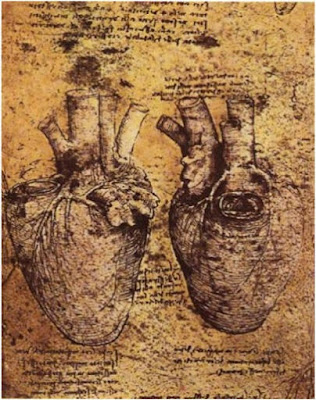In accordance to being a true “Renaissance
Man”, Leonardo da Vinci exercised his inquisitiveness, aptitude, and innovation
in science; particularly in the discipline of Anatomy. Da Vinci truly made use of his favored
empirical method in investigating the human body, as well as plants and
animals, when he dissected and performed autopsies on an estimated 30
bodies.
The purpose of his anatomical studies was
to investigate the anatomy and physiology in birth, life, and death and to
discover and record his findings for an accurate understanding of anatomical
knowledge. As he performed his
dissections, he drew 3-dimensional artistic images with annotated notes by candlelight. Leonardo da Vinci collected his records and
drawings for his Treatise of Anatomy. Unfortunately, it was never published before
Leonardo’s death in 1519. Confirmed by
modern technology such as CT scans and MRIs, Da Vinci’s unfinished treatise
proved his unprecedented farsightedness in sciences illustrated by his
innovative drawing techniques depicting accurate movement and physiology of the
human body.
The Vituvian Man was how Leonardo
Da Vinci understood the proportions of the human body. These ideas and
thoughts were not from Leonardo Da Vinci, they were from a Roman architect
named Vitruvius. He drew a male figure that had a circle and a square around
him to clearly measure the body and dynamic. Leonardo took these ideas to try
and discover more about the structure of the body.
 |
| The Vituvian Man |
“Leonardo
da Vinci’s embryological drawings of the fetus in the womb and his accompanying
observational annotations are found in the third volume of his private
notebooks” (Gilson).
 |
| Embryo in the Womb |
Heart
Leonardo Da Vinci was the first known to have
discovered the cause of heart disease.
In performing his autopsy investigations, Da Vinci exposed build up,
known to us as cholesterol, in the vessels of the heart which disrupted normal blood
flow prohibiting proper functions of the heart.
 |
| Brain |
Leonardo Da Vinci was a pioneer in neuroanatomy and neurophysiology discovering meningeal vessels, sensory input, and cavities and sinuses of the brain. He was the first to construct a cast of a body structure when he injected hot was into the brain of an ox. This gave Da Vinci a detailed mold of the brain which portrayed detailed configurations.
Authors: Karen Brown & Meg Heppner

Fantastic job! Please add a few rods from yourself, your opinions about this work of Leonardo, what do you like the most, what is the most amazing in this, etc. It can be added as a comment or in the body, whatever you want!
ReplyDeleteFor me, the Vituvian Man is iconic because it is the first 'layout' for what is considered in all science and anatomy books to be the correct anatomical structure. The palms are up, feet are flat as if standing, and from this positions the planes are drawn. Leonardo's understanding of even the most intricate body structures, like the sensory nerves and meningeal layers of the brain is revolutionary for his time. But what is most amazing to me is his understanding of the physiology of these structures and his keen perception of cause and effect within the body.
ReplyDeleteThe most interesting thing to me is the Vituvian man. I just think it is so incredible how little he really knew back then but created such an accurate drawing that is still around today. I honestly did not know that Leonardo had anything to do with the human anatomy. When I first read through the topics I was not sure I would enjoy this one, but I actually found it very interesting and informative.
ReplyDeleteThe Vituvian man is quite incredible to me. It so fascinating the little knowledge he knew and was able to lay out though his paintings. I have to say this page informed me a lot about Leonardo and its incredible how he knew some of the things he did back.
ReplyDeleteHave to say I had no idea Leonardo's interest in anatomy of the body until this assignment. His work and accuracy is just fascinating.
ReplyDeleteI've always known about Leonardo's appreciation to the body's anatomy, i loved how you explain everything, very interesting topic of your choice
ReplyDelete